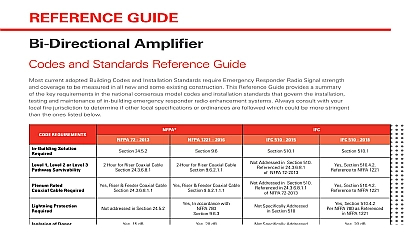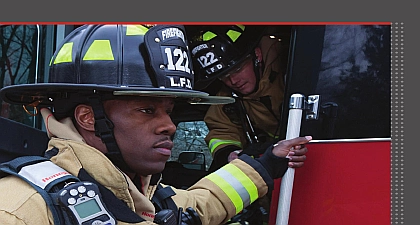Notifier Bi-Directional Amplifiers Emergency Responder Radio Coverage Systems Quick Reference Guide

File Preview
Click below to download for free
Click below to download for free
File Data
| Name | notifier-bi-directional-amplifiers-emergency-responder-radio-coverage-systems-quick-reference-guide-1503864927.pdf |
|---|---|
| Type | |
| Size | 758.29 KB |
| Downloads |
Text Preview
How is the NOTIFIER BDA Unique BDA Amplifiers Responder Coverage Systems Reference Guide 2524 Listed IFC 2009 Compliant IFC 2015 Compliant IFC 2018 Compliant NFPA 72 Compliant NFPA 1221 Compliant FCC Compliant Dedicated Reduction with Operation Noise During Idle Fire Alarm Module Direct Interconnection Factory Training Purchase FCC License Purchase Non Code Compliant BDA Systems reduce gain return to normal operation If Oscillation continues system powers off and all coverage is lost a Honeywell Fire Authorized Engineered Distributor who is factory trained and certified BDA ERCES systems to see if the Honeywell BDA is right for your facility provided under license from Safer Buildings All Rights Reserved More Information Clintonville Road CT 06472 I Rev 01 I 02 20 2020 Honeywell International Inc Requirements and Product Standards Radio Communication Enhancement ERCES were first introduced in the 2009 Building Code The ERCES requirement established to address the performance emergency responders portable radios inside because building construction building size features and other elements can absorb block radio communications Codes like the IBC 2015 Section 916 IFC 2018 510 NFPA 72 2010 NFPA 1221 2016 require all to have an approved level of radio coverage the building based on the existing coverage of the public safety communication systems the jurisdiction at the exterior of the building can be achieved by enhancing the in building frequency signal coverage with an ERCES which of a BDA Signal Booster and Distributed System DAS product performance listing and standard only recently introduced for ERCES UL2524 provides AHJs A Es and building owners certainty from an independent third party that systems are code compliant installed BDA systems will provide reliable for emergency responders are NFPA requirements for annunciator the FACP or is FACP monitoring adequate dedicated annunciator panel must be located the fire command center or other location by the AHJ The BDA status must also monitored by the building fire alarm system the Building Code require BDAs for Police Fire Departments code requires coverage for Emergency The AHJ will determine which Responder agencies need to be included the system Generally it includes Fire Fire Mutual Police and EMS determines what public safety agencies to be supported under the provisions for Responder Radio Coverage AHJ will determine which agencies will need skills education or experience must technician have to install commission and service BDA system depends on the jurisdiction but typically FCC or approved equivalent and manufacturer to Determine if a BDA System is Beneficial to Your Building RF Survey must be performed Typically performed by specialized FCC GROL certified technician and some department radio personnel a RF Survey is accomplished by measuring the Downlink Uplink signal strengths decibels milliwatts dBm using special measuring devices survey can be determined before the building construction starts with a signal survey on the building site by software simulated radio propagation modeling This results in heat maps that show predicted signal levels Results are submitted to AHJ to determine if a BDA is required or if a waiver is appropriate and Standards Reference Guide current adopted Building Codes and Installation Standards require Emergency Responder Radio Signal strength coverage to be measured in all new and some existing construction This Reference Guide provides a summary the key requirements in the national consensus model codes and installation standards that govern the installation and maintenance of in building emergency responder REQUIREMENTS Solution 72 2013 1221 2016 24.5.2 9.6 510 2015 510.1 510 2018 510.1 1 Level 2 or Level 3 Survivability Hour for Riser Coaxial Section 24.3.6.8.1 for Riser Coaxial Section 9.6.2.1.1 Rated Cable Required Riser Feeder Cable Section Riser Feeder Coaxial Section 9.6.2.1.1.1 Addressed in Section 510 in 24.3.6.8.1 NFPA 72 2013 Addressed in Section 510 in 24.3.6.8.1.1 NFPA 72 2013 Protection addressed in Section In accordance with 780 Section 9.6.3 Specifically Addressed Section 510 of Donor Required Power Source 15 dB Section 24.5.2.3.3 Hours 24.5.2.5.5.2 20 dB 9.6.9 Hours 9.6.12.2 Specifically Addressed Section 510 Hours 510.4.2.3 Section 510.4.2 to NFPA 1221 Section 510.4.2 to NFPA 1221 Section 510.4.2 NFPA 780 as Referenced NFPA 1221 20 dB 510.4.2.4 4 Hours Section 510.4.2.3 2 Hours Battery Emergency Generator Strength and Coverage Required Fire Alarm Required for Equipment and Backup Required Antenna Required Acceptance dBm Section 24.5.2.3 General Section 24.5.2.2.2 Critical 24.5.2.2.1 3.0 Section 9.6.8 General Section 9.6.7.5 Critical Section 9.6.7.4 dBm Section 510.4.1 General Section 510.4.1 Critical Not Specifically in Section 510 3.0 Section 510.4.1.1 General Section 510.4.1 Critical Section 510.4.2 to NFPA 1221 Section 24.5.2.6 Section 9.6.13 NEMA 4 NEMA 4X 24.5.2.5.2 Donor Antenna 24.5.2.6 2 a NEMA 4 NEMA 4X 9.6.11.2 Donor Antenna 9.6.13.1 2 a Section 24.5.2.6 72 2013 NEMA 4 510.4.2.4 1 2 Section 24.5.2.6 2 a 72 2013 Section 9.6.13 1221 2016 NEMA 4 NEMA 3R 510.4.2.4 1 2 Donor Antenna 510.4.2.5 24.5.2.1.2 9.6.4 11.3.9 11.3.9.1 510.5.3 510.5.3 NFPA 1 Section 11.10 In all new and existing buildings minimum radio signal strength for fire department communications shall be maintained a level determined by the AHJ Where required by the AHJ two way radio communication enhancement systems shall comply with NFPA 1221


